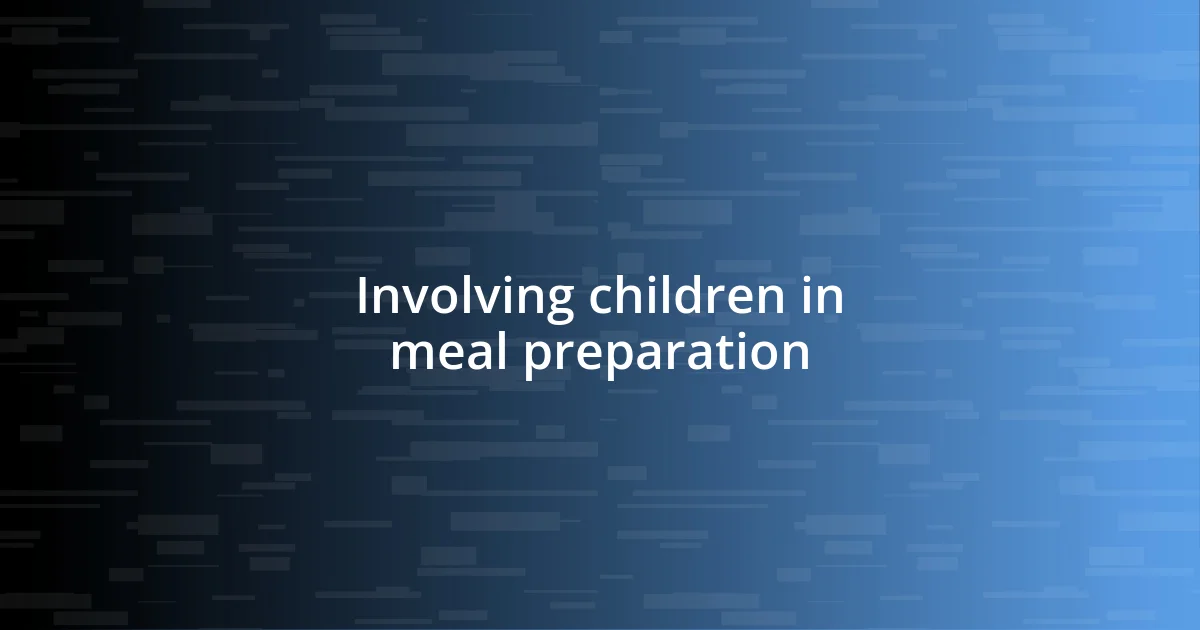Key takeaways:
- Picky eating is influenced by developmental, sensory, and social factors; understanding these can help address food preferences.
- Creative presentation and involvement in meal preparation can significantly encourage children to try new foods and enhance their mealtime experience.
- Monitoring progress through check-ins and being flexible with food choices fosters a supportive environment for children, encouraging their independence and exploration in eating.

Understanding picky eating habits
Picky eating is often more than just a phase; it can stem from a mix of developmental stages, sensory sensitivities, and even personality traits. When my younger cousin refused to touch anything green, I realized her aversion wasn’t just stubbornness; it was about how those textures made her feel. Have you ever wondered if there’s a deeper reason behind a child’s food preferences?
For many, the mealtime experience can be overwhelming, especially with strong flavors or unfamiliar textures. I distinctly remember a family dinner where my son recoiled at the sight of a new dish, looking like it was a monster from a movie. It struck me then that the anxiety surrounding food could be just as impactful as the food itself. Isn’t it fascinating how our emotions can shape our eating habits?
Understanding picky eating habits also involves recognizing that social pressures influence our choices. I once felt the urge to conform at a friend’s gathering, only to find that I was forcing myself to eat something I genuinely disliked. It made me think, how often do our eating struggles reflect a desire for acceptance rather than personal preference? This dynamic can complicate the already challenging journey of addressing picky eating.

Strategies to introduce new foods
One effective way to introduce new foods is to make the experience enjoyable rather than stressful. I remember a rainy afternoon spent in the kitchen with my daughter, experimenting with different smoothies. We threw in spinach, but we called it “superhero green” to make it sound fun. This light-hearted approach not only brought in new flavors but also established a positive association without pressure.
Here are some strategies that I’ve found helpful:
-
Incorporate into favorites: Mix new foods with dishes they already love. For instance, adding broccoli to mac and cheese can stealthily introduce a green veggie.
-
Make it a sensory experience: Let kids touch, smell, and even play with new foods to spark curiosity. I once had my son create art with fruits and veggies before tasting them.
-
Use creative naming: Renaming foods can make them more appealing. For example, calling Brussels sprouts “little cabbages” intrigued my nephew enough to give them a try.
-
Be patient and persistent: Don’t rush the process. I recall serving a new dish multiple times before my picky eater even considered it, but with each exposure, curiosity grew.
-
Get them involved: Allow children to help in the kitchen. I found that when my daughter chopped and arranged her veggies, she was more eager to eat what she had prepared.

Creative ways to present meals
One often-overlooked method of tackling picky eating is by presenting meals in a playful manner. I once arranged a dinner as a colorful rainbow on the plate—different fruits and veggies forming a vibrant arch. Not only did my daughter marvel at the artwork, but she also felt compelled to taste each color. Have you ever thought how a little creativity could transform mealtime?
Fancy utensils and plate designs can also work wonders. I remember using animal-shaped cookie cutters to make sandwiches and veggies more fun. Suddenly, a simple meal of turkey and cheese turned into “dinosaur bites,” and my son couldn’t resist trying a little extra. It’s amazing how these small changes made such a big difference in how he perceived food.
Finally, the element of surprise can further enhance the presentation. Lifting a lid to reveal hidden layers in a casserole can spark curiosity and excitement. I recall making a layered veggie lasagna and revealing it to my family like a magician unveiling a trick. The thrill of discovery inspired everyone to dig in without hesitation. It left me pondering: how often do we underestimate the power of a creative presentation?
| Presentation Method | Description |
|---|---|
| Colorful Arrangements | Creating visually appealing plates with different colors can entice kids to explore new foods. |
| Fun Shapes | Using cookie cutters to shape food into fun designs increases interest and excitement around meals. |
| Surprise Elements | Revealing hidden layers in dishes adds an element of surprise that can intrigue and encourage tasting. |

Building a positive mealtime environment
Creating a positive mealtime environment is crucial in shaping how children interact with food. I vividly remember those evenings when we’d gather around the table, candlelight flickering, transforming a regular dinner into a cozy gathering. This atmosphere not only encouraged conversation but also made even the simplest meals feel special. Have you ever noticed how a warm, inviting environment can change the mood entirely?
To foster a stress-free dining experience, I found it beneficial to set aside distractions like screens and toys. I once made a rule that we’d keep the phones away during dinner, and it was enlightening to see how this small change led to deeper discussions about our days. Suddenly, my kids were sharing stories and laughing, making mealtime something they looked forward to rather than a chore.
Moreover, I’ve seen the impact of involving everyone in the meal preparation. The sheer excitement on my daughter’s face when she helped pick fresh veggies at the farmer’s market was priceless. Watching her enthusiasm transform into hunger once dinner was served was a testament to the positive energy we cultivated. Isn’t it incredible how engagement in the process can lead to a greater enjoyment of the outcome?

Involving children in meal preparation
Involving children in meal preparation can be a game changer for encouraging them to try new foods. I remember one specific Saturday when I decided to let my son be in charge of our pancake breakfast. He mixed the batter, chose the toppings, and even dictated the shape of the pancakes. Watching him excitedly create his breakfast made him much more willing to taste the unique combinations he had whipped up. Have you ever noticed how ownership can lead to curiosity about food?
Another enriching experience was when my daughter joined me in the garden to pick herbs for our dinner. The joy on her face as she discovered basil and rosemary was heartwarming. Together, we chopped the fresh herbs, and I saw a shift in her attitude towards the meal; she couldn’t wait to taste the flavors we were creating. It’s striking how involving kids in the process not only teaches them about food but also builds a bond over shared tasks.
Even small tasks, like letting them choose a side dish or help wash vegetables, can give kids a sense of pride. I’ll never forget the time my daughter insisted on adding a splash of lemon juice to our roasted veggies. It turned out to be a fantastic decision, and she beamed with pride as we all enjoyed the dish. How empowering is it to see a child’s choices directly impacting the meal? It’s moments like these that foster a deeper connection with food, shifting perspectives and making them more willing to try new tastes.

Monitoring progress and adjusting plans
Monitoring the journey of overcoming picky eating can often feel like a rollercoaster ride. I remember tracking my kids’ meal preferences on a simple chart, noting each time they tried something new. It was surprising how such a straightforward visual could spark motivation. Have you found that when you see your progress laid out, it feels more tangible?
As we ventured into new recipes, I quickly learned the importance of being flexible. There were times when a meal I was excited about fell flat with the kids. Instead of being discouraged, I adjusted our approach, opting for different textures or flavors that sparked their interest. It’s funny how a change in presentation—like turning broccoli into “trees” with a fun dip—could make all the difference. Hasn’t it been true for you that sometimes a little creativity makes the unfamiliar seem less intimidating?
Regular family check-ins became a vital part of our routine too. After a week of trying new things, we’d sit down and chat about what worked and what didn’t. I found it incredibly insightful to hear my kids express their preferences, often leading to surprising revelations. For instance, my son once admitted he loved carrots, but only when they were roasted. Who would’ve guessed that? This kind of open dialogue forged trust and encouraged them to share their thoughts on food without fear of judgment. How valuable is it to have kids feel empowered in their choices while helping shape the family meal plan?














